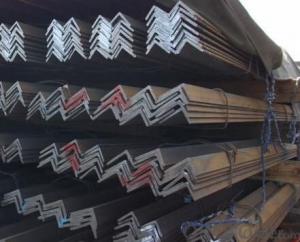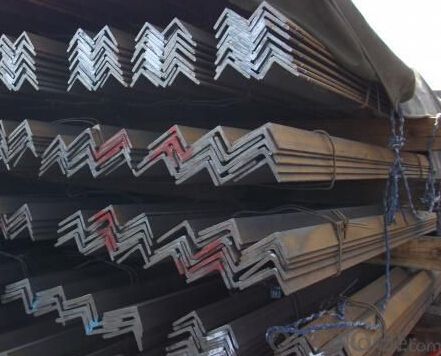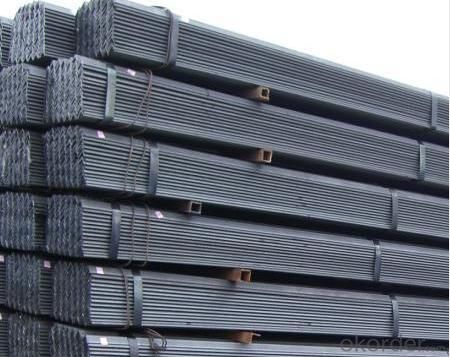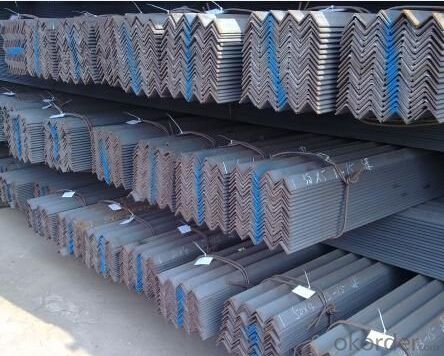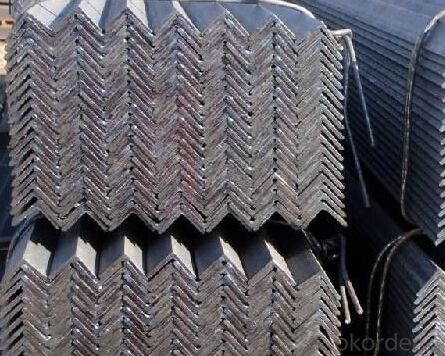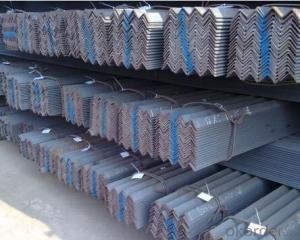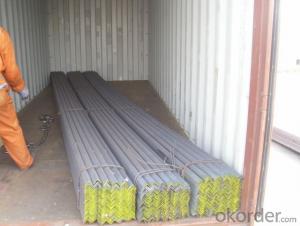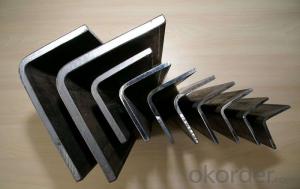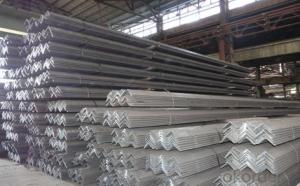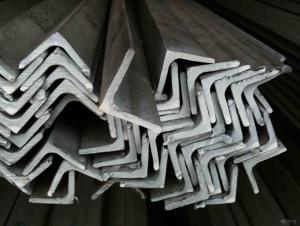Stainless Equal Angle Steel with Standards:GB,ASTM,BS,AISI,DIN,JIS
- Loading Port:
- Tianjin
- Payment Terms:
- TT or LC
- Min Order Qty:
- 100 m.t.
- Supply Capability:
- 1000 m.t./month
OKorder Service Pledge
OKorder Financial Service
You Might Also Like
Product Description:
OKorder is offering Stainless Equal Angle Steel with Standards:GB,ASTM,BS,AISI,DIN,JIS at great prices with worldwide shipping. Our supplier is a world-class manufacturer of steel, with our products utilized the world over. OKorder annually supplies products to European, North American and Asian markets. We provide quotations within 24 hours of receiving an inquiry and guarantee competitive prices.
Product Applications:
Stainless Equal Angle Steel with Standards:GB,ASTM,BS,AISI,DIN,JIS are ideal for structural applications and are widely used in the construction of buildings and bridges, and the manufacturing, petrochemical, and transportation industries.
Product Advantages:
OKorder's Stainless Equal Angle Steel with Standards:GB,ASTM,BS,AISI,DIN,JIS are durable, strong, and resist corrosion.
Main Product Features:
· Premium quality
· Prompt delivery & seaworthy packing (30 days after receiving deposit)
· Corrosion resistance
· Can be recycled and reused
· Mill test certification
· Professional Service
· Competitive pricing
Product Specifications:
Specifications of Equal Angle Steel
1.Standards:GB,ASTM,BS,AISI,DIN,JIS
2.Length:6m,9m,12m
3.Material:GBQ235B,Q345BorEquivalent;ASTMA36;EN10025,S235JR,S355JR;JISG3192,SS400;SS540..
4.Sizes:
EQUAL ANGLES SIZES |
| ||
a(mm) | a1(mm) | thickness(mm) | length |
25 | 25 | 2.5---3.0 | 6M/12M |
30 | 30 | 2.5---4.0 | 6M/12M |
38 | 38 | 2.5 | 6M/12M |
38 | 38 | 3.0---5.0 | 6M/12M |
40 | 40 | 3.0---6.0 | 6M/12M |
50 | 50 | 3 | 6M/12M |
50 | 50 | 3.7---6.0 | 6M/9M/12M |
60 | 60 | 5.0---6.0 | 6M/9M/12M |
63 | 63 | 6.0---8.0 | 6M/9M/12M |
65 | 65 | 5.0---8.0 | 6M/9M/12M |
70 | 70 | 6.0---7.0 | 6M/9M/12M |
75 | 75 | 5.0---10.0 | 6M/9M/12M |
80 | 80 | 6.0---10.0 | 6M/9M/12M |
90 | 90 | 6.0---10.0 | 6M/9M/12M |
100 | 100 | 6.0---12.0 | 6M/9M/12M |
120 | 120 | 8.0-12.0 | 6M/9M/12M |
125 | 125 | 8.0---12.0 | 6M/9M/12M |
130 | 130 | 9.0-12.0 | 6M/9M/12M |
140 | 140 | 10.0-16.0 | 6M/9M/12M |
150 | 150 | 10---15 | 6M/9M/12M |
160 | 160 | 10---16 | 6M/9M/12M |
180 | 180 | 12---18 | 6M/9M/12M |
200 | 200 | 14---20 | 6M/9M/12M |
5. Material details:
Alloy No | Grade | Element (%) | |||||
C | Mn | S | P | Si | |||
|
|
|
|
|
|
| |
Q235 | B | 0.12—0.20 | 0.3—0.7 | ≤0.045 | ≤0.045 | ≤0.3 | |
|
|
|
|
|
|
| |
Alloy No | Grade | Yielding strength point( Mpa) | |||||
Thickness (mm) | |||||||
≤16 | >16--40 | >40--60 | >60--100 | ||||
≥ | |||||||
|
|
|
|
|
| ||
Q235 | B | 235 | 225 | 215 | 205 | ||
Alloy No | Grade | Tensile strength (Mpa) | Elongation after fracture (%) | ||||
Thickness (mm) | |||||||
| ≤16 | >16--40 | >40--60 | >60--100 | |||
≥ | |||||||
|
|
|
|
|
|
| |
Q235 | B | 375--500 | 26 | 25 | 24 | 23 | |
Usage & Applications of Equal Anlge Steel
Trusses;
Transmission towers;
Telecommunication towers;
Bracing for general structures;
Stiffeners in structural use.
Packaging & Delivery of Equal Angle Steel
1. Transportation: the goods are delivered by truck from mill to loading port, the maximum quantity can be loaded is around 40MTs by each truck. If the order quantity cannot reach the full truck loaded, the transportation cost per ton will be little higher than full load.
2. With bundles and load in 20 feet/40 feet container, or by bulk cargo, also we could do as customer's request.
3. Marks:
Color mark: There will be color marking on both end of the bundle for the cargo delivered by bulk vessel. That makes it easily to distinguish at the destination port.
Tag mark: There will be tag mark tied up on the bundles. The information usually including supplier logo and name, product name, made in China, shipping marks and other information request by the customer.
If loading by container the marking is not needed, but we will prepare it as customer request.
FAQ:
Q1: Why buy Materials & Equipment from OKorder.com?
A1: All products offered byOKorder.com are carefully selected from China's most reliable manufacturing enterprises. Through its ISO certifications, OKorder.com adheres to the highest standards and a commitment to supply chain safety and customer satisfaction.
Q2: How do we guarantee the quality of our products?
A2: We have established an advanced quality management system which conducts strict quality tests at every step, from raw materials to the final product. At the same time, we provide extensive follow-up service assurances as required.
Q3: How soon can we receive the product after purchase?
A3: Within three days of placing an order, we will begin production. The specific shipping date is dependent upon international and government factors, but is typically 7 to 10 workdays.
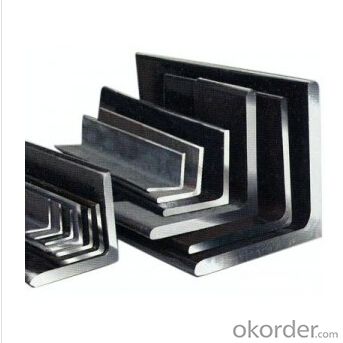
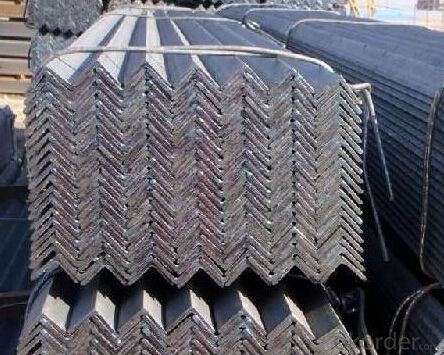
- Q: Bearing capacity of angle steel and channel steel
- Angle called angle, the steel strip is perpendicular to each other on both sides into the corner. There are equal angles and unequal angles. The two sides of an equal angle steel are equal in width. The specifications are expressed in millimeters of edge width * edge width * edge thickness. Such as "/ 30 x 30 x 3", that is 30 mm width equal angle, edge thickness of 3 mm. Also available models that model is the number of centimeters wide, such as angle 3#. The model does not mean the size of the different edges and sizes of the same model. Therefore, the width, the edge and the thickness of the angle iron should be filled out in the contract and other documents, so as not to be indicated by the model alone. Standard Specification for hot-rolled equal angle iron is 2#-20#. The angle iron can be made up of different force components according to the different structure, and can also be used as the connecting piece between the components. Widely used in a variety of architectural and engineering structures, such as beams, bridges, towers, hoisting and conveying machinery, ships, industrial furnace, reaction tower, container frame and warehouse.Angle steel performance index: the performance test of angle iron is mainly tensile test and bending test. Indicators include yield point, tensile strength, elongation and bending compliance.
- Q: Can steel angles be used in residential construction?
- Yes, steel angles can be used in residential construction. Steel angles are versatile structural elements that are commonly used in various construction applications, including residential buildings. They are often used for framing, reinforcing, and providing structural support in walls, roofs, and floors. Steel angles are preferred in residential construction due to their strength, durability, and ability to withstand heavy loads. They can be easily welded, bolted, or screwed into place, making them suitable for a wide range of construction projects. Additionally, steel angles can be galvanized or coated to enhance their resistance to corrosion, ensuring their longevity. Overall, steel angles are a reliable and cost-effective choice for residential construction.
- Q: Can steel angles be used in seismic applications?
- Yes, steel angles can be used in seismic applications. Steel angles are commonly used in seismic applications to provide structural support, stability, and resistance against seismic forces. They are often used in the construction of buildings, bridges, and other structures to reinforce connections, bracing, and framing systems, making them suitable for seismic applications.
- Q: Can steel angles be used in the construction of shopping malls?
- Yes, steel angles can be used in the construction of shopping malls. Steel angles are commonly used in structural applications, including the construction of commercial buildings like shopping malls. They provide strength, stability, and support, making them a suitable choice for various structural elements such as frames, columns, and beams in shopping mall construction.
- Q: How do you determine the strength of a steel angle?
- The strength of a steel angle can be determined by several factors, including its material composition, size, and shape. First, the material composition of the steel angle is crucial in determining its strength. Steel angles are typically made from various alloys, such as carbon steel or stainless steel, which have different strength properties. The specific grade or type of steel used will affect its strength, with higher-grade steels generally having greater strength. Second, the size of the steel angle plays a significant role in determining its strength. The dimensions of the angle, including its length, width, and thickness, directly impact its load-bearing capacity. Generally, larger and thicker steel angles are capable of withstanding higher loads and forces. Lastly, the shape of the steel angle also influences its strength. Commonly, steel angles come in L-shapes, where the two legs are perpendicular to each other. The length and angle of the legs can affect the strength of the angle. For example, longer legs or a steeper angle between the legs can increase the strength and load-bearing capacity of the steel angle. To determine the precise strength of a steel angle, engineering calculations and analysis are typically performed. These calculations involve considering the material properties, dimensions, and loading conditions to determine the maximum load or stress the angle can withstand without failure. Additionally, industry standards and codes, such as those set by organizations like the American Society for Testing and Materials (ASTM) or the American Institute of Steel Construction (AISC), provide guidelines and specifications for determining the strength of steel angles.
- Q: Can steel angles be used for supports in construction?
- Certainly! Steel angles are indeed suitable for use as supports in construction. These versatile and strong components are commonly employed in construction projects to serve as structural supports. They find application in a wide range of uses, including supporting beams, columns, and frames. Steel angles are highly advantageous as they provide stability and rigidity to the structure, enabling them to support heavy loads and withstand forces like gravity and wind. Furthermore, they offer the convenience of easy welding or bolting together, ensuring a speedy and efficient installation process. All in all, steel angles are a favored choice for construction supports due to their durability, strength, and user-friendly nature.
- Q: Are steel angles suitable for vehicle ramps?
- Yes, steel angles are suitable for vehicle ramps. Steel angles are commonly used in construction and are known for their strength and durability. They provide a sturdy and stable surface for vehicles to drive on, making them a suitable choice for vehicle ramps. Additionally, steel angles can be easily welded or bolted together to create a customized ramp design that meets specific requirements. Overall, steel angles are a reliable and practical option for constructing vehicle ramps.
- Q: Decoration materials and what is the difference between the angle steel bracket.
- Steel bracket is connected, and the surface material is keel connection decoration, also can be connected with embedded parts of the keel, or connected with a decorative auxiliary frame and so on, he is a small connector, and the angle is the angle steel and is probably a meaning, can be considered to rectangular plates, but the angle is relatively small, not like a big plate!Steel bracket, is composed of a horn steel cutting, and many of the same model can be welded steel bracket! Of course, understanding can be understood, but in reality no corner welded steel!
- Q: Can steel angles be used in machine frames?
- Yes, steel angles can be used in machine frames. Steel angles provide structural support and stability, making them suitable for constructing machine frames. They can withstand heavy loads and offer excellent resistance to bending and twisting forces, making them a popular choice in various industrial applications.
- Q: What is the maximum allowable bearing stress for a steel angle?
- The maximum bearing stress that a steel angle can withstand depends on several factors, including the type of steel, angle thickness and size, and specific application or design requirements. Generally, the maximum bearing stress is determined by assessing the angle's structural strength and stability under expected load conditions. To ascertain the maximum bearing stress for a steel angle, it is vital to refer to relevant industry standards, such as the specifications provided by the American Institute of Steel Construction (AISC) or the Eurocode design standards. These standards offer guidelines and formulas to calculate the maximum bearing stress based on the angle's properties and load factors. Moreover, factors like the presence of additional reinforcements, corrosion or surface imperfections, and the method of connection or support can also impact the maximum bearing stress. Hence, it is crucial to consult the appropriate design codes and seek advice from a structural engineer or steel design expert in order to accurately determine the maximum allowable bearing stress for a specific steel angle in a given application.
Send your message to us
Stainless Equal Angle Steel with Standards:GB,ASTM,BS,AISI,DIN,JIS
- Loading Port:
- Tianjin
- Payment Terms:
- TT or LC
- Min Order Qty:
- 100 m.t.
- Supply Capability:
- 1000 m.t./month
OKorder Service Pledge
OKorder Financial Service
Similar products
Hot products
Hot Searches
Related keywords
